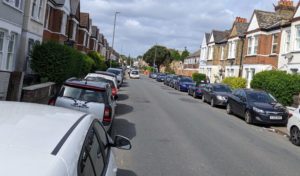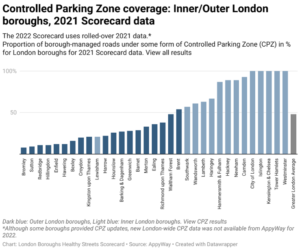Why we need more action on parking, now!
We recently wrote a Letter to Seb Dance, London’s Deputy Mayor for transport, making the case for stronger action on parking issues. Here’s why.
We’ve written before about What connects rural England and healthy streets in London. We’ve also done a lot of work over the past two years to promote action on parking. Our interest lies in the vast amount of public space it takes up: at least 3,000 hectares, roughly half of which is on-street (estimated at 1,400 hectares or the equivalent of 10 Hyde Parks). This space has often unconsciously been prioritised for parking over many other important potential uses. In the context of the climate, nature and health crises, we believe some of this space should be used to support other green infrastructure including much needed new ‘streetparks’, pocket parks, parklets, rain gardens, tree planting, other street infrastructure (which can be placed on build-outs, rather than on the pavement where they take space from pedestrians) as well as to clear the way for bus and cycle lanes to promote sustainable transport. This will enable less use of cars and create a virtuous circle where more and more space is freed up.

In 2020 we published Eight Ways to Transform Parking and Make London a Better Place which sets out the key issues around parking and outlines potential ways forward for both TfL and the boroughs
Restricting parking (removing it or charging for it) is the Number One way to promote a shift from car journeys to more use of public transport, walking and cycling – and we believe that, to meet the Mayor’s Transport Strategy targets, boroughs will need to take much more action on parking.
As part of the Healthy Streets Scorecard we publish data which shows a huge variation in the proportion of the boroughs’ streets with parking controls. In five boroughs, nearly 100% of streets have parking controls; by contrast in the Inner London borough of Lewisham just 21% of streets have controlled parking. Added to this, parking on Council Estates is rarely treated the same as on-street parking – in any borough.
These two issues are just examples of the relatively straightforward and cost-neutral parking related interventions which could have a dramatic impact on delivering MTS targets, pretty much overnight.
More recently, our concern that not enough emphasis is being placed on parking led us to publish the Local Authority Parking Policy Benchmark and Assessment Tool, to enable boroughs and local campaigners to easily identify areas for improvement. We are currently promoting that toolkit.
Continuing to push for action on parking, this week we wrote to Deputy Mayor for Transport, Seb Dance, asking:
- Given the importance of parking policy, can LIP guidance (this is the guidance TfL provides for boroughs) do more to promote action on parking, specifically widening the use of controls for on-street and estate parking?
- Will TfL eliminate parking on the TLRN on all existing bus routes and where new bus or cycle priority is needed.
- Will TfL remove the frequent practice of vehicles being allowed to drive over the pavement (from TLRN roads) to access parking in front of shops etc (this issue has been raised with the Walking and Cycling Commissioner)?
- Will TfL encourage boroughs to propose changes to parking on the TLRN to promote bus and cycle priority and promote better town centres and high streets e.g. by promoting the removal of bays on main roads (placing them instead on side-streets)?
- Will TfL enable boroughs to manage Controlled Parking Zones on the TLRN so parking is not free?
- Will TfL take immediate action to implement double yellow (red!) lines where parking on the TLRN is currently uncontrolled e.g. on the A10 Evering Road between Leswin Rd and Manse Rd.
We look forward to discussing these issues with the Deputy Mayor and will keep you posted!








